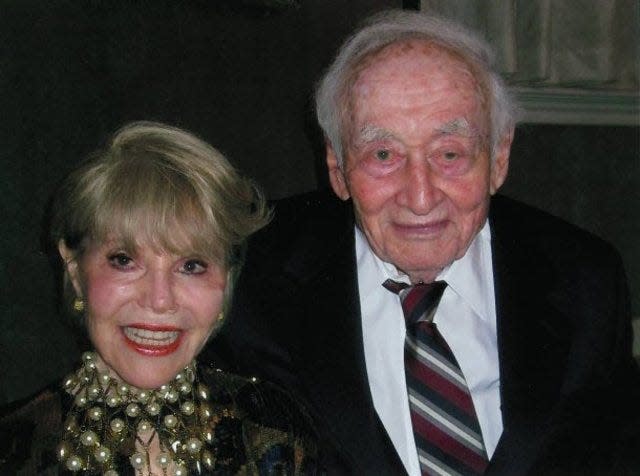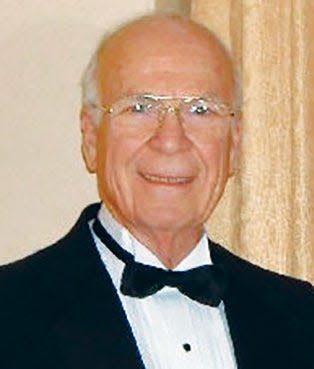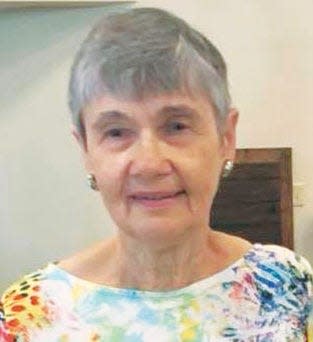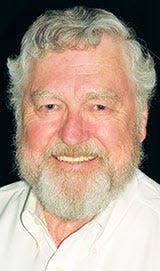Read about the prominent Jewish leaders with strong ties to Oak Ridge, Knoxville
- Oops!Something went wrong.Please try again later.
- Oops!Something went wrong.Please try again later.
Carolyn Krause completes the two-part series on Jewish businessmen and scientific leaders who have been influential for Oak Ridgers, based on Wendy Besmann’s recent talk in Oak Ridge on “The Jewish Experience in East Tennessee” and other sources.

***
When Wendy Besmann spoke in May in Oak Ridge on “From Peddlers to Ph.D.’s – The Jewish Experience in East Tennessee” for the local “Our American Roots: Exploration of Cultures” series, she mentioned that many Jewish scientists with doctoral degrees had moved to and lived in Oak Ridge. First, they came to help meet the secret goals of the Manhattan Project – to provide fuel for an atomic bomb that would hasten the end of World War II. Then they stayed to make advancements in nuclear medicine, nuclear energy for power generation, radioisotope production, basic research and technologies to meet national needs, including national security.

In her interview with the late Herb Hoffman, a scientist retired from Oak Ridge National Laboratory and a member of the Jewish Congregation of Oak Ridge, he told her that many of the Jewish scientists who remained in the city had never affiliated with the Jewish community. Since Jews like to be around other Jews, he surmised, many joined the Oak Ridge synagogue, an action they might not have taken if they had settled in a big city someplace else.
Arguably, the most famous scientists with Jewish heritage who lived and worked in Oak Ridge were Eugene Wigner, a Hungarian Jewish immigrant, and Alvin Weinberg, son of Russian Jewish immigrants. Neither were known to be religiously observant. Wigner was a research director in the mid-1940s at what became ORNL, and Weinberg was the renowned director of ORNL from 1955 to 1973. Wigner received the Nobel Prize in Physics in 1963 for his contributions to the theory of the atomic nucleus and the elementary particles.
Both Wigner and Weinberg made significant contributions to the design of nuclear reactors; Weinberg co-invented the pressurized water reactor that is at the heart of two-thirds of the nuclear power plants that provide carbon-free electricity worldwide. Weinberg championed the development of the molten salt reactor at ORNL, which may well be the basis for a clean, safe, reliable and affordable source of electricity later this century.
In her book “A Separate Circle: Jewish Life in Knoxville, Tennessee” (University of Tennessee Press), Besmann focused mostly on Jewish merchants who lived in the Knoxville area. However, in her talk she mentioned two Jewish businessmen who affected the shopping life of Oak Ridgers. More about that later.
From the Knoxville Chronicle to the New York Times
In her talk, Besmann told the story New York Times readers here like. It was about Adolph Ochs, a German Jew who grew up in Knoxville, delivered newspapers and worked for the Knoxville Chronicle (which became the Knoxville Journal). He was an office assistant to the newspaper’s editor, who was also his mentor. At age 19 in the 1870s, he borrowed $250 from his family to purchase a controlling interest in the Chattanooga Times of which he became the publisher.
In 1896, he learned from a reporter that the New York Times, which was struggling with financial woes and intense competition, could be purchased at a bargain price. At age 38, Ochs borrowed $75,000 to buy the Times, formed The New York Times Company, improved its financial position and became its majority stockholder.
According to Besmann, “Adolph Ochs came up with the slogan, ‘All the news that’s fit to print,’ and his cousin Jacob, whose family owned a cigar store on Gay Street, put up a sign that read, ‘All the cigars fit to smoke.’”
Many Jews in East Tennessee took advantage of the new economic opportunities that arose after World War II, she said, adding that, “People had money and wanted to buy all the goods they couldn’t get their hands on during the war. The Jews of Knoxville were willing to sell their goods to them.”
Dozens of Jewish businesses sprang up to sell items such as beauty supplies, jewelry, clothing, fish, meat and other foods.
In the 1950s and 1960s, Jewish furniture manufacturers from the North moved to nearby Morristown to take advantage of its cheap, non-union labor. Besmann said that some Jews who prospered in Morristown started their own country club, knowing they weren’t welcome at the country clubs consisting mostly of white Christians (until the 1980s).
Elvis got help from a Knoxville businessman
At a small store on Knoxville’s Market Square next to the Market House (before it was burned down by a teenager’s tossed cigarette), Sam Morrison, a Jew with the Bell Sales Company, sold records and helped launch one of the most famous careers in musical history. Besmann said Morrison played some of his records on loudspeakers to attract shoppers on the square to his store. He discovered that playing Elvis Presley’s “That’s All Right, Mama” on the square enabled him to sell hundreds of copies of this record to people of all ages.
Morrison shared his discovery with an RCA talent scout who stopped by in his search for local country music talent. The scout bought two of the Elvis records and sent one to his boss in New York after informing him of its popularity. Several months later, RCA purchased Elvis’ contract with Sun Studios in Memphis.

Guilford Glazer, the state of Israel, and the Oak Ridge Shopping Center
An Eastern European Jew who immigrated to America to escape persecution and poverty was Oscar Glazer. He and his wife Ida were the parents of Guilford Glazer (1921-2014), who built the Oak Ridge Shopping Center between 1951 and 1955, launching his career as a real-estate developer; in 1960 he moved to Los Angeles and developed the Del Amo Fashion Center, which in the 1970s was the world’s largest shopping mall.
When antisemitism rose to an intolerable level in Atlanta in the early 20th century, Oscar Glazer “packed up his horse and buggy and moved to Knoxville, where he rode across the countryside peddling scrap,” Besmann said. Later, this father of eight children became a welder. When he died in 1939, his family’s scrap yard and welding business was struggling financially.
Guilford Glazer, a graduate of Knoxville High School who had attended two universities before joining the Navy as a shipbuilder, returned to Knoxville and realized his family was in financial trouble. With other family members, Glazer turned his father’s business into the Glazer Steel Corp., a Knoxville firm that fabricated steel bridges and other structures for customers ranging from Kaiser Aluminum to the government of France.
According to Wikipedia, “While still the chairman of Glazer Steel Corp., Guilford entered the real estate development business in Knoxville. The first building that Glazer developed was Shelbourne Towers near the University of Tennessee campus in Knoxville, described as Knoxville’s first high-rise apartment building.
“His entry into the real-estate development business occurred in 1951, when the U.S. Atomic Energy Commission selected a company headed by Glazer to build a shopping center in Oak Ridge, Tenn. A shortage of steel resulting from the Korean War delayed construction, but the center opened in 1955.”
According to Besmann and Glazer’s obituary published on Dec. 28, 2014, in the Los Angeles Times, Glazer was a wealthy man, a philanthropist who started the Guilford and Diane Glazer Foundation, a member of the Heska Amuna Synagogue in Knoxville and an active supporter of Israel and the Zionist movement for decades.
The Glazers also opened the Diane and Guilford Glazer Institute of Jewish Studies in China and California.
In 1951, according to the Los Angeles Times, “he escorted political leaders of the new state of Israel when they came to his hometown of Knoxville, Tenn., to tour the Tennessee Valley Authority’s massive complex of dams and power plants. The delegation included Prime Minister David Ben-Gurion, future Prime Minister Golda Meir and Teddy Kollek, a future mayor of Jerusalem.” Besmann showed a photo of Glazer with these famous Israeli politicians. For a much better understanding of Guilford Glazer’s relationship and support of Israel, see: https://english.tau.ac.il/content/profile-guilford-glazer.

Mel Sturm
An East Tennessee Jew who knew Glazer well was the late Mel Sturm, who died on March 1, 2021, in Oak Ridge. According to his obituary, he “was one of the founding merchants at the groundbreaking for the original downtown shopping center in Oak Ridge, opening a children’s clothing store, after the developer suggested that would meet a need of the community. He owned and operated Sturm’s Youth World and Backstage until he sold it to a friend in 1979. He was a well-respected businessman, and many people sought him out for advice as they were contemplating business or personal decisions.”
Besmann mentioned Sturm as an example of a college-educated Jew whose parents ran a retail business. She noted that Eli Evans, a southern Jewish writer, had said that “the story of the Jewish South has been that the Jewish parents had built businesses their children didn’t want.” She added: “The sons and daughters of most Jewish merchants in Knoxville and elsewhere went to college. Some attended college on the GI Bill and others with their parents’ help.”
Sturm’s parents faced difficult times operating diners and other retail stores to serve the needs of railroad workers and small towns in Virginia and Tennessee. At age 16 he enrolled at the University of Tennessee in Knoxville. He worked his way through school and at the age of 20, he earned a degree in mechanical engineering. He served briefly in the Navy during World War II before taking an engineering job in Chicago.
“Shortly thereafter,” his obituary stated, “he took a leave from work to go to Jellico to ostensibly close his father’s business after his dad was killed in an automobile accident at the age of 59. After a few months of running his father’s store, he decided to stay in Jellico. He became mayor of Jellico at age 29 and he lived the rest of his life in East Tennessee, moving to Oak Ridge in 1955 as a newlywed, with his wife, Frances.”
He and Fran established a scholarship to encourage Oak Ridge High School seniors to learn more about the U.S. and world economy and to assist students in continuing their education. In 1999, after the untimely death of their son, Bradley, the scholarship was named the Oak Ridge Rotary Club Brad Sturm Memorial Scholarship.
After her talk, Besmann was asked why Jews have frequently been “kicked out of places” where they have been prospering, creating jobs and contributing to the communities where they live. She said she and her husband Ted recently took a Jewish history class at the University of South Carolina. She learned that hatred of the Jews, “is perhaps one of the oldest and most entrenched forms of hatred in the world.” Such antisemitism, defined as hostility to or prejudice against Jewish people, seems so wrong since so many Jews do such good in the world.

***
Thanks, Carolyn, for another excellent review of one of the exceptional talks in the series "Our American Roots."
D. Ray Smith is the city of Oak Ridge historian. His "Historically Speaking" column is published each week in The Oak Ridger.

This article originally appeared on Oakridger: Weinberg, Wigner, Glazer, Sturm: Jewish leaders with ties to Oak Ridge

